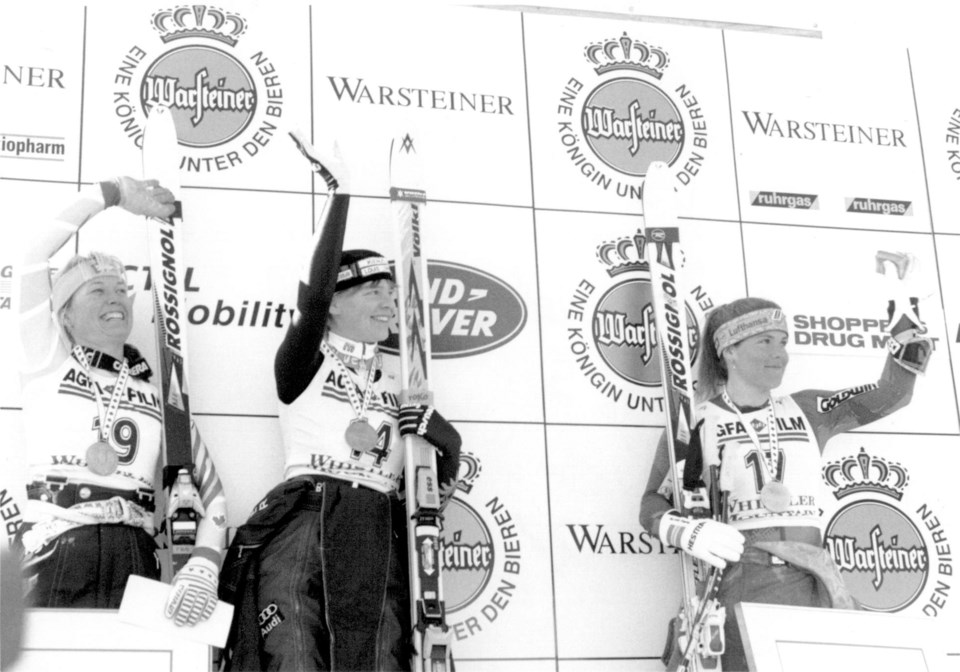Though Whistler began hosting World Cup races in 1982 (or 1979, depending on how you look at it), in early 1994, the resort was preparing to host its first Women’s World Cup downhill on March 5 and 6, followed a week later by a Men’s World Cup downhill and super-G.
In January, volunteers were still being recruited to join the ranks of veteran Weasel Workers, and it was expected they would start setting up the course on Dave Murray Downhill by the end of the month. According to the Whistler Question, the Dave Murray Downhill course was considered “one of a few ‘classic’ downhill courses,” with jumps, flats, drop-offs, high-speed turns, and more. Some changes were made to the course in 1992 to make it more exciting for racers and more accessible for fans, including the addition of two off-camber turns below Coaches’ Corner and the Hot Air jump.
As in many years, the weather was a popular topic in the lead-up to the World Cup races, and many were concerned about whether the races would be able to go ahead. January 1994 was unseasonably warm, prompting the Question to ask readers, “Is the recent warm weather giving you spring fever?” By the beginning of February, Whistler Mountain had to announce changes to the Peak to Valley race course, because there was not enough snow to ski down to the valley. Instead, the start of the race was moved higher up—to just below the Saddle entrance to the Glacier Bowl—and the course was shortened.
Worries about the snow eased on Feb. 8, 1994, when 28 centimetres fell overnight. According to a report from Bonny Makarewicz, “Skiers and merchants woke up with smiles on their faces as the countdown to the World Cup has begun in earnest.”
The snow continued to fall, and at the end of February, the mountains received nine feet of snow in nine days. At the beginning of March, however, the weather had turned again, and planned training runs for the inaugural Warsteiner Women’s World Cup races were cancelled. When team captains examined the course on March 2, they found the snow was too soft to be safe for training runs, and volunteer crews were scheduled to work all day to re-anchor nets and fences left unsecure after the course lost 40 cm of snow overnight.
Despite poor conditions, chief of race Joan Giannelli remained optimistic. The rest of her leadership team (which included Nancy Greene as race chair, Michelle Brown, Andrée Janyk in charge of gatekeepers, and Brenda Oakes as chief of timing) agreed, and their optimism was rewarded. Training runs were held on Friday, March 4, and the race was able to go ahead on the weekend. Katja Seizinger of Germany placed first, followed by Pernilla Wiberg of Sweden and Michelle Ruthven of Canada.
World Cup events in Whistler included more than just the races. The Kokanee Rock N’ Ski Party featured eight different bands performing on a bar circuit, and the Whistler Village Art Gallery featured works of B.C. sports artists Dale Cooper, Brent Lynch and Ken Wesman in the second-annual World Cup Show. Other newsworthy events that took place during the World Cup races included the announcement by Canadian racer Kerrin Lee-Gartner of her retirement and the gathering of Canada’s Olympic and World Downhill gold medallists at a benefit dinner for the Whistler Health Care Centre.
Despite continued uncertain weather, the Men’s World Cup downhill and super-G races were also able to go ahead the following week, and the 1994 World Cup in Whistler was considered a success. However, while the Men’s World Cup races did return in February 1995, the Women’s World Cup did not, and the Canadian stop of the tour was moved to December in Lake Louise.




